INSTITUIT SUPERIEUR D'ANTHROPOLOGIE
INSTITUT OF ANTHROPOLOGY
COURS ONLINE – COURS A DISTANCE
INSCRIPTIONS : SEPTEMBRE 2023
REGISTER NOW
ANGLETERRE – 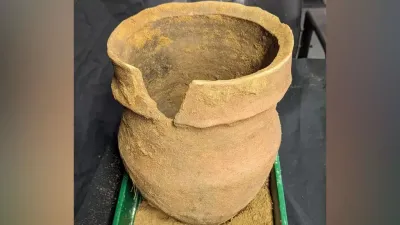 Ely - An intact Bronze Age pot and a previously unknown Saxon village with a large hall were among the "exceptional" finds unearthed during a dig. Britannia Archaeology experts have been working on the site near Ely, Cambridgeshire, for nearly a year. The nearly intact 35cm-high (14in) late Neolithic or early Bronze Age urn, dating back about 4,000 years old, was a particularly rare find. Evidence unearthed so far reveals the site was occupied right up until the Roman period and then was apparently abandoned until the 4th or 5th Century AD village was built. At least 20 buildings has been excavated including a "substantial hall" and they are believed to be part of a much larger Saxon settlement, said Mr Brook.A high proportion of the buildings unearthed so far were dug into the ground and several appear to have been used as workshops. Other buildings were dug even deeper below ground, up to 80cm (31in), and have revealed evidence of industrial use. "We have found loom weights, spindle whorls, needles and tiny, tiny beads - blink and you'd miss them," she said. "You think, 'somebody last touched this thousands of year ago', yet some of these artefacts look like they could have been created yesterday."The excavation will continue until Christmas and then post-excavation analysis will begin.
Ely - An intact Bronze Age pot and a previously unknown Saxon village with a large hall were among the "exceptional" finds unearthed during a dig. Britannia Archaeology experts have been working on the site near Ely, Cambridgeshire, for nearly a year. The nearly intact 35cm-high (14in) late Neolithic or early Bronze Age urn, dating back about 4,000 years old, was a particularly rare find. Evidence unearthed so far reveals the site was occupied right up until the Roman period and then was apparently abandoned until the 4th or 5th Century AD village was built. At least 20 buildings has been excavated including a "substantial hall" and they are believed to be part of a much larger Saxon settlement, said Mr Brook.A high proportion of the buildings unearthed so far were dug into the ground and several appear to have been used as workshops. Other buildings were dug even deeper below ground, up to 80cm (31in), and have revealed evidence of industrial use. "We have found loom weights, spindle whorls, needles and tiny, tiny beads - blink and you'd miss them," she said. "You think, 'somebody last touched this thousands of year ago', yet some of these artefacts look like they could have been created yesterday."The excavation will continue until Christmas and then post-excavation analysis will begin.
Intact Bronze Age pot found during excavation near Ely - BBC News
ISRAEL –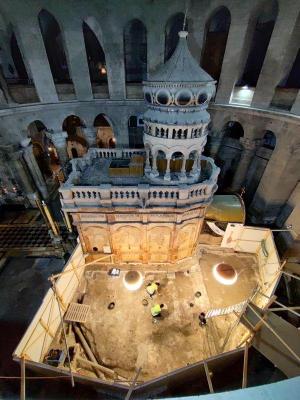
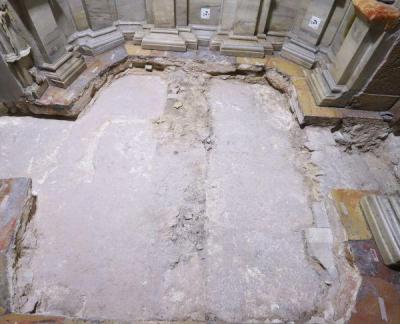 Jerusalem - Jerusalem’s Church of the Holy Sepulcher, one of the holiest places in the world for Christians and an important pilgrimage site since the fourth century, is revealing more of its secrets. Ongoing archaeological investigations related to the restoration of the basilica’s floor are at a turning point, with many surprises coming to light. The latest — and one of the most significant — findings emerged during the investigations conducted during the second half of June in the area in front of the edicule — the small shrine/temple that encloses the tomb of Jesus located in the center of the rotunda, under the big dome of the basilica. The excavations have exposed the marble steps leading to the edicule and a coin deposit, which were most recently minted during the reign of Emperor Valens (364–378). This allows archeologists to accurately date the early Christian edicule to that period. Located in the northwest quarter of the Old City of Jerusalem, the Church of the Holy Sepulcher is believed to be the site of Jesus’ crucifixion, death, and resurrection. Constantine the Great built the first church there, dedicated in about 336 A.D. His mother, St. Helena, was believed to have found a relic of the cross of Christ’s crucifixion on the site. Almost 300 years later, the Persians burned the church down, after which it was restored, destroyed again, and restored once more. The Crusaders in the 12th century undertook a rebuild of the site, which included a chapel in St. Helena’s honor. Since that time, frequent restorations and repairs have taken place. Other discoveries that emerged during the first year of work involve the remains of the early Christian liturgical basilica — a construction site of the Constantinian age — and the foundations of the northern perimeter wall of the complex and the water drainage system in the northwestern area of the rotunda, next to the edicule. Archeologists also discovered that the quarry in the southern part of the rotunda, an area outside the city walls, was used as a cave. The cave was dismantled in the first century B.C. and transformed into an agricultural and burial area. “We are gaining an in-depth understanding of the entire stratigraphic sequence [the order and position of layers of archeological remains]: from the use of the quarry in pre-Constantinian times to the restoration work during the British Mandate [for Palestine],” Francesca Romana Stasolla, the leader of the team from the Department of Ancient Sciences at the University of Rome Sapienza responsible for the archaeological research, told CNA in an interview. Stasolla said her team can now trace “the entire material history of the religious complex.”
Jerusalem - Jerusalem’s Church of the Holy Sepulcher, one of the holiest places in the world for Christians and an important pilgrimage site since the fourth century, is revealing more of its secrets. Ongoing archaeological investigations related to the restoration of the basilica’s floor are at a turning point, with many surprises coming to light. The latest — and one of the most significant — findings emerged during the investigations conducted during the second half of June in the area in front of the edicule — the small shrine/temple that encloses the tomb of Jesus located in the center of the rotunda, under the big dome of the basilica. The excavations have exposed the marble steps leading to the edicule and a coin deposit, which were most recently minted during the reign of Emperor Valens (364–378). This allows archeologists to accurately date the early Christian edicule to that period. Located in the northwest quarter of the Old City of Jerusalem, the Church of the Holy Sepulcher is believed to be the site of Jesus’ crucifixion, death, and resurrection. Constantine the Great built the first church there, dedicated in about 336 A.D. His mother, St. Helena, was believed to have found a relic of the cross of Christ’s crucifixion on the site. Almost 300 years later, the Persians burned the church down, after which it was restored, destroyed again, and restored once more. The Crusaders in the 12th century undertook a rebuild of the site, which included a chapel in St. Helena’s honor. Since that time, frequent restorations and repairs have taken place. Other discoveries that emerged during the first year of work involve the remains of the early Christian liturgical basilica — a construction site of the Constantinian age — and the foundations of the northern perimeter wall of the complex and the water drainage system in the northwestern area of the rotunda, next to the edicule. Archeologists also discovered that the quarry in the southern part of the rotunda, an area outside the city walls, was used as a cave. The cave was dismantled in the first century B.C. and transformed into an agricultural and burial area. “We are gaining an in-depth understanding of the entire stratigraphic sequence [the order and position of layers of archeological remains]: from the use of the quarry in pre-Constantinian times to the restoration work during the British Mandate [for Palestine],” Francesca Romana Stasolla, the leader of the team from the Department of Ancient Sciences at the University of Rome Sapienza responsible for the archaeological research, told CNA in an interview. Stasolla said her team can now trace “the entire material history of the religious complex.”
New discoveries may change what we know about Jerusalem’s Basilica of the Holy Sepulcher | Catholic News Agency
ANGLETERRE – 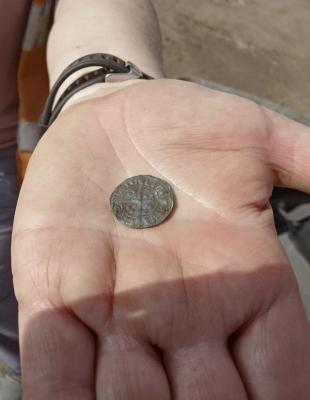 Severn Stoke - Work on excavating the medieval village found in St Denys Church in Severn Stoke has came to a halt while great crested newts are being captured in the area. The newts are a protected species and will need to be identified and removed before any work continues on the site and on the Severn Stoke flood defences. The archaeological site, located southwest and west of the church, is believed to be a 'high status' settlement that was deserted and shrank over time. It is said the medieval village found in the small village could have been abandoned and forgotten due to the plague. During excavations, several features were found that may be the boundary of a high-status building, possibly a medieval hall. A motte and bailey - a medieval castle which was made up of two connecting mounds with a higher section housing a 'keep' and a lower one with barracks and other buildings - is believed to be in Severn Stoke. Along with this, an Edward I hammered coin dating between 1272 to 1307 was uncovered.
Severn Stoke - Work on excavating the medieval village found in St Denys Church in Severn Stoke has came to a halt while great crested newts are being captured in the area. The newts are a protected species and will need to be identified and removed before any work continues on the site and on the Severn Stoke flood defences. The archaeological site, located southwest and west of the church, is believed to be a 'high status' settlement that was deserted and shrank over time. It is said the medieval village found in the small village could have been abandoned and forgotten due to the plague. During excavations, several features were found that may be the boundary of a high-status building, possibly a medieval hall. A motte and bailey - a medieval castle which was made up of two connecting mounds with a higher section housing a 'keep' and a lower one with barracks and other buildings - is believed to be in Severn Stoke. Along with this, an Edward I hammered coin dating between 1272 to 1307 was uncovered.
Excavations stop on medieval village at Severn Stoke church | Worcester News
SUEDE – 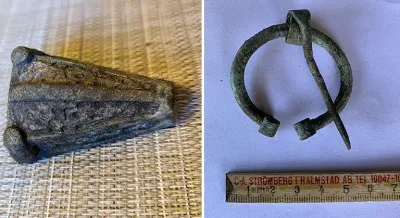 Gotland - Two medieval buckles were discovered this summer on the southern part of the Swedish island of Gotland. The first one was spotted by an 8-year-old boy. Bruno Tillema was vacationing with his family when he came across an object that turned out to be an animal head-shaped bronze buckle dated to the Viking Age (800-1100 AD)..Gotland’s museum has during the week carried out an archaeological investigation at the find site to find out if there are more objects nearby. During the investigation, another suit buckle was found, this time a so-called ring buckle. “Both buckles are made of bronze and belong to costumes from the late Iron Age or early Viking Age,” Lindström notes. “Buckles designed as animal heads are usually associated with Gotland women’s graves, while ring buckles are found in both men’s and women’s graves.” The grave itself has probably been damaged on an earlier occasion. It is not uncommon for objects from damaged graves to come to the surface in connection with plowing the land.
Gotland - Two medieval buckles were discovered this summer on the southern part of the Swedish island of Gotland. The first one was spotted by an 8-year-old boy. Bruno Tillema was vacationing with his family when he came across an object that turned out to be an animal head-shaped bronze buckle dated to the Viking Age (800-1100 AD)..Gotland’s museum has during the week carried out an archaeological investigation at the find site to find out if there are more objects nearby. During the investigation, another suit buckle was found, this time a so-called ring buckle. “Both buckles are made of bronze and belong to costumes from the late Iron Age or early Viking Age,” Lindström notes. “Buckles designed as animal heads are usually associated with Gotland women’s graves, while ring buckles are found in both men’s and women’s graves.” The grave itself has probably been damaged on an earlier occasion. It is not uncommon for objects from damaged graves to come to the surface in connection with plowing the land.
Viking-age bronze buckle discovered in Gotland - Medievalists.net
ECOSSE – 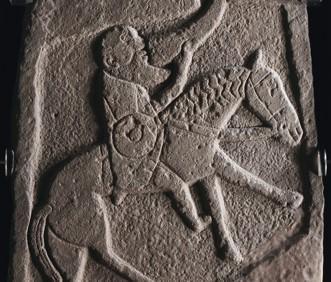 Invergowrie - Tipsy and glugging heartily from a booze filled ox horn, eyes bulging and with a ‘hands-free’ approach to steering his mount, he’s a very merry pickled Pict on a rather despondent pony. Carved more than 1,000 years ago and discovered in a field in Invergowrie in the 1930s, the large Pictish stone with its quirky ‘drunk driver’ is one of a kind – amusing but also baffling. Now Pictish art enthusiasts and scholars are hoping to unravel some of the merry man’s secrets and figure out who he was, what on earth he was up to and why someone thought he should be immortalised in stone. Known as the Bullion Stone and measuring a hefty 6ft 2ins long and 2ft 5ins wide, the carved sculpture is kept at the National Museum of Scotland, where the considerably worse for wear rider and his weary mount feature on popular merchandising from hip flasks to goblets and bags. However, according to the Pictish Arts Society, while his image has become well-recognised and hugely popular, so far there has been little research into who he might have been and why he was in such a sloshed state. It has gathered together a group of international experts spanning archaeology, art history and Pictish culture for a two day online conference next month which will explore theories, ignite debate and possible solve some of his mysteries. Professor Jane Geddes, President of the Pictish Arts Society and one of the speakers at the Society’s conference, says the distinctive carving showing the bald bearded warrior, complete with slight paunch and shield, is a particularly intriguing example of Pictish stonework. “The image shows a Pictish warrior carrying his weapon, but he is not riding like a Pictish warrior,” she says. “They sit up straight and smart, but he is slumped in his saddle holding an enormous drinking horn full of alcohol. You can work out from the way he holds it that the contents will be slurping all over his face and you can see from his bulging eyeballs that he is probably hallucinating. “Over the top of the horn, is a bird’s beak. It’s looking right at him and he is looking back, thinking ‘what the heck is this in front of me?’“Normally Pictish horses are shown with their legs well up and treading very smartly, but this one is staggering - he is taking his master home without being steered with the reigns. “It’s completely unique in Pictland and goes against everything we associate with Pictish society.“There was a strong drinking culture, but it would be done in a hall with their leader and was a way of male bonding - they sang, told stories and got drunk together. To be alone and riding a horse is extraordinary. One theory recently put forward to the Society has suggested the well-oiled warrior may have his roots in ancient Rome, and the classical god Silenus. He is often depicted in art as rather worse for wear, sitting on a donkey with a horn of drink in his hand as part of the entourage accompanying his pupil, the far more respectable Bacchus – or Dionysus. “But how on earth did Picts in Invergowrie in the 9th century know about Silenus from Roman times?”The answer, she says, could lie in East Lothian, at Traprain Law where a huge treasure of Roman silver was discovered during excavations in 1919, and included some dishes showing images of Bucchus. It’s suspected that similar silverware showing Bucchus and his large entourage, including the drunken Silenus, were also in circulation and perhaps melted down by Picts and the silver repurposed - possibly providing inspiration for the Bullion Stone character.“There are many fantastic Roman dishes that show both Bucchus and Silenus, and we know dishes were given to the Picts because of the silver found at Traprain Law,” she adds. “Most would have been melted down to make brooches, but someone in Angus must have known about the image of Silenus on a donkey.“Even if they didn’t understand the story of Bucchus and Ensileuse, they could see a drunk man on a horse looking very funny.
Invergowrie - Tipsy and glugging heartily from a booze filled ox horn, eyes bulging and with a ‘hands-free’ approach to steering his mount, he’s a very merry pickled Pict on a rather despondent pony. Carved more than 1,000 years ago and discovered in a field in Invergowrie in the 1930s, the large Pictish stone with its quirky ‘drunk driver’ is one of a kind – amusing but also baffling. Now Pictish art enthusiasts and scholars are hoping to unravel some of the merry man’s secrets and figure out who he was, what on earth he was up to and why someone thought he should be immortalised in stone. Known as the Bullion Stone and measuring a hefty 6ft 2ins long and 2ft 5ins wide, the carved sculpture is kept at the National Museum of Scotland, where the considerably worse for wear rider and his weary mount feature on popular merchandising from hip flasks to goblets and bags. However, according to the Pictish Arts Society, while his image has become well-recognised and hugely popular, so far there has been little research into who he might have been and why he was in such a sloshed state. It has gathered together a group of international experts spanning archaeology, art history and Pictish culture for a two day online conference next month which will explore theories, ignite debate and possible solve some of his mysteries. Professor Jane Geddes, President of the Pictish Arts Society and one of the speakers at the Society’s conference, says the distinctive carving showing the bald bearded warrior, complete with slight paunch and shield, is a particularly intriguing example of Pictish stonework. “The image shows a Pictish warrior carrying his weapon, but he is not riding like a Pictish warrior,” she says. “They sit up straight and smart, but he is slumped in his saddle holding an enormous drinking horn full of alcohol. You can work out from the way he holds it that the contents will be slurping all over his face and you can see from his bulging eyeballs that he is probably hallucinating. “Over the top of the horn, is a bird’s beak. It’s looking right at him and he is looking back, thinking ‘what the heck is this in front of me?’“Normally Pictish horses are shown with their legs well up and treading very smartly, but this one is staggering - he is taking his master home without being steered with the reigns. “It’s completely unique in Pictland and goes against everything we associate with Pictish society.“There was a strong drinking culture, but it would be done in a hall with their leader and was a way of male bonding - they sang, told stories and got drunk together. To be alone and riding a horse is extraordinary. One theory recently put forward to the Society has suggested the well-oiled warrior may have his roots in ancient Rome, and the classical god Silenus. He is often depicted in art as rather worse for wear, sitting on a donkey with a horn of drink in his hand as part of the entourage accompanying his pupil, the far more respectable Bacchus – or Dionysus. “But how on earth did Picts in Invergowrie in the 9th century know about Silenus from Roman times?”The answer, she says, could lie in East Lothian, at Traprain Law where a huge treasure of Roman silver was discovered during excavations in 1919, and included some dishes showing images of Bucchus. It’s suspected that similar silverware showing Bucchus and his large entourage, including the drunken Silenus, were also in circulation and perhaps melted down by Picts and the silver repurposed - possibly providing inspiration for the Bullion Stone character.“There are many fantastic Roman dishes that show both Bucchus and Silenus, and we know dishes were given to the Picts because of the silver found at Traprain Law,” she adds. “Most would have been melted down to make brooches, but someone in Angus must have known about the image of Silenus on a donkey.“Even if they didn’t understand the story of Bucchus and Ensileuse, they could see a drunk man on a horse looking very funny.
The Bullion Stone of Invergowrie: Scotland's Pictish mystery | The Herald (heraldscotland.com)
ALLEMAGNE – 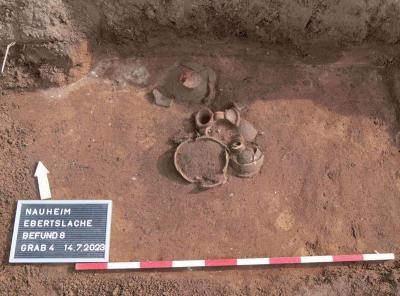 Nauheim - Students from Goethe University Frankfurt, in collaboration with the Hesse archeology department at the Darmstadt branch of the State Monument Protection Agency, uncovered 46 graves from various ethnic groups near Nauheim, a town southwest of Frankfurt in the central-western German state of Hessen. They uncovered 46 graves from the time when Roman legions were stationed on the Rhine during a six-week training excavation. The grave goods indicate the deceased were immigrants with Gallic funerary customs who settled in the area in the middle of the 1st century A.D. The team expected to find Roman remains because a Roman military camp was known to have been built in the Nauheim area. The graves of early settlers came as a surprise. The burial ground, which eight students in two teams brought to light on a good 2,000 square meters, dates from the middle of the 1st century AD to the beginning of the 3rd century. They unearthed a total of 46 graves, 44 of them cremation burials, only two of them inhumations. Anthropologists will now examine the bone remains from the corpse fire as well as the skeletons and determine the age at death, gender, and diseases. The Nauheim graves show who settled on the borders of the Hessian Ried almost 2,000 years ago: immigrant ethnic groups in small-scale groups. Grave goods indicate Germanic military farmers who were deliberately attracted by the Romans from the north, took over the security service in the province on the border of the Roman Empire, and then settled down. In the burial area, a 30-centimeter high vessel, in particular, indicated that the dead of newly arrived settlers found their final resting place here: a bronze bucket that probably served as a burial urn. An early Nauheimer “in the bucket”. Burying a person in a bronze bucket and providing tools such as scissors or knives is atypical for Roman burials. This is also the first time that evidence of the grave enclosures mentioned has been found in southern Hesse, while the custom was widespread on the left of the Rhine in the east of Gaul in the late Iron Age (1st century BC) and the 1st century AD. For scientists, such unusual burials are clear signs that immigrants were buried here, bringing not only their culture but also their burial rites with them.
Nauheim - Students from Goethe University Frankfurt, in collaboration with the Hesse archeology department at the Darmstadt branch of the State Monument Protection Agency, uncovered 46 graves from various ethnic groups near Nauheim, a town southwest of Frankfurt in the central-western German state of Hessen. They uncovered 46 graves from the time when Roman legions were stationed on the Rhine during a six-week training excavation. The grave goods indicate the deceased were immigrants with Gallic funerary customs who settled in the area in the middle of the 1st century A.D. The team expected to find Roman remains because a Roman military camp was known to have been built in the Nauheim area. The graves of early settlers came as a surprise. The burial ground, which eight students in two teams brought to light on a good 2,000 square meters, dates from the middle of the 1st century AD to the beginning of the 3rd century. They unearthed a total of 46 graves, 44 of them cremation burials, only two of them inhumations. Anthropologists will now examine the bone remains from the corpse fire as well as the skeletons and determine the age at death, gender, and diseases. The Nauheim graves show who settled on the borders of the Hessian Ried almost 2,000 years ago: immigrant ethnic groups in small-scale groups. Grave goods indicate Germanic military farmers who were deliberately attracted by the Romans from the north, took over the security service in the province on the border of the Roman Empire, and then settled down. In the burial area, a 30-centimeter high vessel, in particular, indicated that the dead of newly arrived settlers found their final resting place here: a bronze bucket that probably served as a burial urn. An early Nauheimer “in the bucket”. Burying a person in a bronze bucket and providing tools such as scissors or knives is atypical for Roman burials. This is also the first time that evidence of the grave enclosures mentioned has been found in southern Hesse, while the custom was widespread on the left of the Rhine in the east of Gaul in the late Iron Age (1st century BC) and the 1st century AD. For scientists, such unusual burials are clear signs that immigrants were buried here, bringing not only their culture but also their burial rites with them.
Roman era total of 46 early settler burials discovered in Germany - Arkeonews